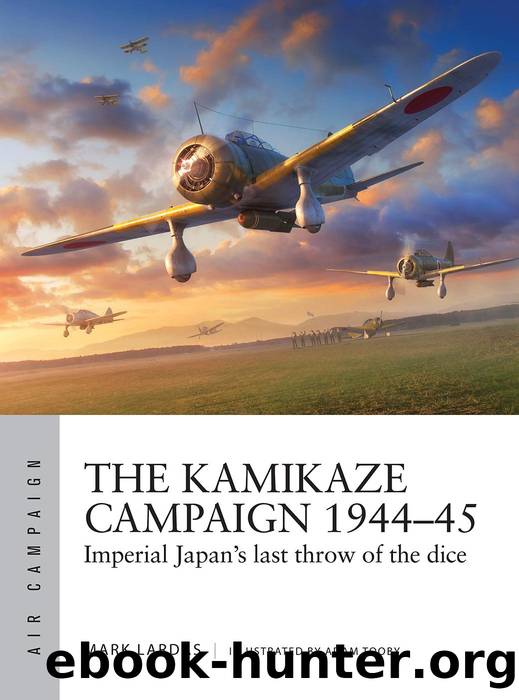The Kamikaze Campaign 1944â45: Imperial Japanâs Last Throw of the Dice by Mark Lardas & Adam Tooby

Author:Mark Lardas & Adam Tooby
Language: eng
Format: epub
Publisher: Bloomsbury Publishing Plc
Published: 2021-12-16T00:00:00+00:00
When TF38 attacked Luzon on November 25, 1944, kamikazes struck back against them. A kamikaze is photographed disintegrating in a fiery explosion after hitting the flight deck of USS Intrepid. (AC)
The Imperial Japanese Armyâs aircraft had not yet participated, even though it established the Banda and Fugaku units in the summer. These consisted of 12 specially converted Ki-48 and Ki-67 twin-engine bombers, respectively. Navy success prompted the Army to commit these units to combat, and to organize an additional 18 tokko units in November with a further 216 aircraft.
The Imperial Japanese Navy renewed its kamikaze attacks on supply ships supporting the Leyte landing on November 11. The Banda and Fugaku units joined in a few days later. Four D3As and a D4Y attacked on November 11, without scoring hits. The Third Kamikaze threw 19 Zeros and the Banda unit of four Ki-48s at the ships the next day, hitting and damaging seven ships: six Liberty ships and the USS Achilles, an LST converted to a repair ship. Two of the Liberty ships were carrying troops, 350 of whom died in the kamikaze strikes.
The Fast Carrier Task Force appeared off Luzon the following day, launching two days of air strikes on Japanese airfields and shipping which drew the kamikazes away from the cargo ships. The Japanese threw most of the Fugaku Ki-67s and four Navy kamikazes against the carriers without scoring a hit. Maneuvering 30-knot carriers proved harder to hit than anchored transports.
The kamikazes returned their attention to the invasion support shipping on November 15. Between then and November 23, they struck again at Leyte Gulf. Six more cargo ships were hit and damaged, including two transports. The damage was the product of only 20 kamikaze aircraft, split evenly between the Navy and Army. Most attacks were made at night, and were conducted individually. As November waned, it was becoming apparent the IJA had lost its battle for Leyte, and was withdrawing. This meant that attacking the support ships was becoming less important, so kamikazes were directed towards other targets.
These other targets included the Big Blue Fleet in the last week of November. TF38, which was working over Luzon every week or so, launched another set of strikes on November 25. This time, only two carrier task groups participated, the other two being tied up with other operations or refitting. This meant fewer aircraft were available for CAP and for hitting Japanese airfields. Their primary targets were whatever Japanese warships and shipping still remained in the vicinity of Luzon. Airfield attacks and fighter sweeps concentrated on northern Luzon, with only cursory coverage of Luzonâs southeastern tail.
Download
This site does not store any files on its server. We only index and link to content provided by other sites. Please contact the content providers to delete copyright contents if any and email us, we'll remove relevant links or contents immediately.
The Radium Girls by Kate Moore(11921)
100 Deadly Skills by Clint Emerson(4840)
Rise and Kill First by Ronen Bergman(4701)
The Templars by Dan Jones(4627)
The Doomsday Machine by Daniel Ellsberg(4415)
The Rape of Nanking by Iris Chang(4136)
Killing England by Bill O'Reilly(3950)
Hitler in Los Angeles by Steven J. Ross(3900)
Stalin by Stephen Kotkin(3875)
12 Strong by Doug Stanton(3508)
Hitler's Monsters by Eric Kurlander(3268)
Blood and Sand by Alex Von Tunzelmann(3138)
The Code Book by Simon Singh(3073)
Darkest Hour by Anthony McCarten(3070)
The Art of War Visualized by Jessica Hagy(2943)
Hitler's Flying Saucers: A Guide to German Flying Discs of the Second World War by Stevens Henry(2714)
Babylon's Ark by Lawrence Anthony(2619)
The Second World Wars by Victor Davis Hanson(2478)
Tobruk by Peter Fitzsimons(2442)
